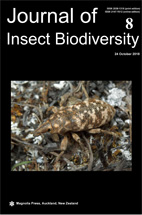Abstract
It is difficult to associate species of the wood-boring moth in the genus Aenetus with their host plant, because larvae develop inside live trees. A new method is described for rearing larvae of Aenetus eximia, A. lewinii, A. blackburnii, A. ligniveren and A. scotti in cut stems of trees containing larval tunnels by feeding them apple pieces. Larvae that completed development were reared from 49 to 396 days after collection from the field. Aspects of larval feeding webs and adult emergence are described, and new host records are documented. The rearing method is shown to provide an effective means of accurately determining the species of Aenetus developing inside a given host plant. It was more convenient than obtaining pupae or emerging adults in the field, which is often not possible to do. The method should be useful for conducting surveys, particularly for species with wide distribution ranges. This method may also be effective for the study of other genera of callus feeding, stem boring Hepialidae, such as Archaeoaenetus, Endoclita, Phassus, Schausiana and Zeloptypia.
References
Common I. F. B. 1970. Lepidoptera (moths and butterflies) In: The Insects of Australia. A Textbook for Students and Research Workers, 765–866. Melbourne: Melbourne University Press.
Common I. F. B. 1990. Hepialoidea. In: Moths of Australia. 140–150. Melbourne: Melbourne University Press.
Froggatt W. W. 1907. Australian Insects. William Brooks Co. Ltd., Sydney. 449 pp.
Grehan J. R. 1981. Morphological changes in the three-phase development of Aenetus virescens larvae (Lepidoptera: Hepialidae). New Zealand Journal of Zoology 8: 505–514.
https://doi.org/10.1080/03014223.1981.10427975
Grehan J. R. 1988a. Evolution of arboreal tunneling by the larvae of Aenetus (Lepidoptera: Hepialidae). New Zealand Journal of Zoology 14: 441–462.
https://doi.org/10.1080/03014223.1987.10423019
Grehan J. R. 1988b. Life cycle of the wood-borer Aenetus virescens (Lepidoptera: Hepialidae). New Zealand Journal of Zoology 14: 209–217.
https://doi.org/10.1080/03014223.1987.10422991
Grehan J. R. 2012. Morphological evidence for phylogenetic relationships within the Hepialidae (Lepidoptera: Exoporia). Bulletin of the Buffalo Society of Natural Sciences 42: 33–62.
Grehan J. R. & Care C. 2018. Recent observations on the entry of trees by larvae of the puriri moth, Aenetus virescens (Lepidoptera: Hepialidae). The Weta: 52: 61–64.
Grehan J. R., Witt T. J. & Ignatyev N. 2018. New Species of Aenetus from Sumatra, Indonesia (Lepidoptera: Hepialidae) and a 5,000 km biogeographic disjunction. Entomofauna 39/2 (in press).
Illidge R. and Quail A. 1901. Australasian wood boring Hepialidae. Proceedings of the Royal Society of Queensland 16: 65–72.
Kallies A., Marriott P. & Hewish M. 2015. Moths of Victoria. Part 6. Ghost moths, Hepialidae and Allies. Melbourne: Entomological Society of Victoria. 36 pp., 1CD.
King C. 1900. Life history notes on moths of the genus Aenetus (Lepidoptera, Hepialidae). Queensland Naturalist 16: 102–103.
Salesne T. 2010. À la recherche de l’Hépiale calédonienne. Insectes 159: 9–13.
Scott A. W. 1869. On the genus Charagia of Walker. Transactions of the Entomological Society of New South Wales 2: 25–35.
Scott A. W. 1864. Australian Lepidoptera and their transformations, drawn from the life by Harriet and Helena Scott. Vol. 1. London: John van Voorst, 30 pp.
https://doi.org/10.5962/bhl.title.51826
Scott A. W. 1890. Australian Lepidoptera and their transformations. Vol 2. Sydney: Australian Museum. 36 pp.
Simonsen T. J. 2018. Splendid ghost moths and their allies. A revision of Australian Abantiades, Oncopera, Aenetus and Zelotypia. Monographs of Australian Lepidoptera 12: 1–312.
Yule K. J. & Burns K. C. 2013. Drivers of aggregation in a novel arboreal parasite: the influence of host size and infra-populations. International Journal of Parasitology 45: 195–202.
Yule K. J. & Burns K. C. 2017a. Adaptive advantages of appearance: predation, thermoregulation, and color of webbing built by New Zealand’s largest moth. Ecology 98: 1324–1333.
https://doi.org/10.1002/ecy.1787
Yule K. J. & Burns K. C. 2017b. Host defense predicts host specificity in a long-lived arboreal parasite. Evolutionary Ecology 31: 37–50.

